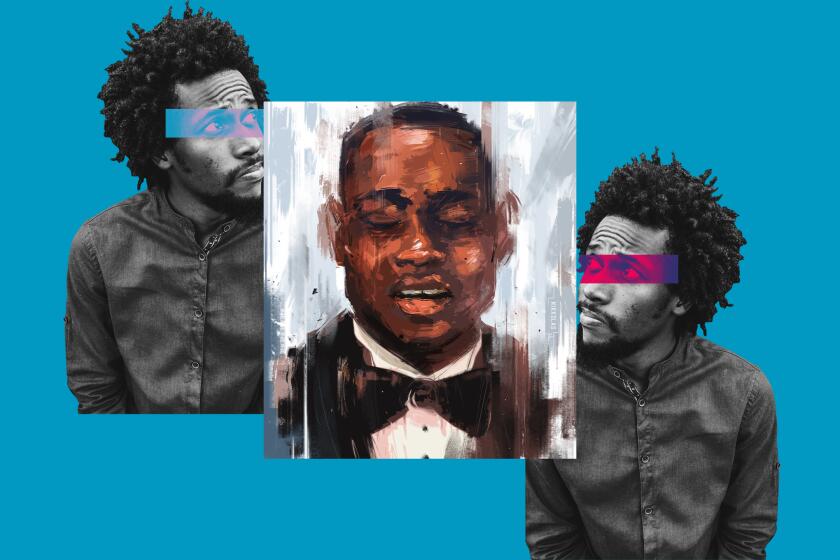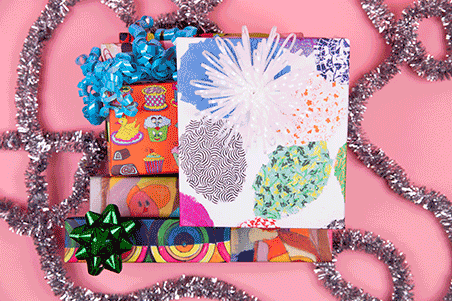How viral Instagram tributes to George Floyd use art to spread a movement
Many outlets hadn’t started covering George Floyd when illustrator and graphic designer Andres Guzman learned of his death, which happened in the same Minneapolis neighborhood where the artist lives.
To spread the word, fast, Guzman created a graphic illustration and posted it to Instagram. He made the artwork, which quickly racked up thousands of views and shares, free for anyone to use.
“I really just wanted to make graphic resources available to people to make posters, shirts,” Guzman said via email. “From past experience, graphics are always needed in the aftermath of unjust systemic attacks on the public.”
Guzman’s work is part of a wave of viral digital art paying tribute to Floyd and other black victims of white violence, including Breonna Taylor and Ahmaud Arbery, as protests rage on throughout the country and even abroad. As celebrities, politicians, activists, students and others use social media to demand justice or call for solidarity, digital art — from portraits to colorful quotes — is serving as a rallying cry to express grief and anger.
The art is a way to uplift lives often reduced to violent images and videos in media coverage, and to serve as a call to action.
In moments of unrest, social media is valuable because of its immediacy, said Guzman, who recently saw his graphic blown up on a poster at a protest. “I feel people now don’t have to wait for the news. They can share the pulse of their own community and be its reporter.”
In early May, L.A. artist Nikkolas Smith posted a digital painting of Arbery, the 25-year-old who was shot after being confronted by a white father and son while jogging through a Georgia neighborhood. It took 2 1/2 months before the men were arrested and charged with felony murder and aggravated assault.
After the post went viral, collecting more than 70,000 likes, the #BlackLivesMatter network commissioned Smith to create a portrait tribute to Floyd.
Using Floyd’s selfie as a reference image, Smith made the digital work with a tablet and Photoshop, emulating the feeling of an abstract acrylic painting on canvas. In Smith’s portrait, Floyd wears a tuxedo. “I wanted to make it a little bit more uplifting and a little bit more stately,” he said.
But the art also acknowledges the pain.
“There’s so much chaos that is going on around these moments that I wanted the brushstrokes to be very textured, almost broken or unfinished, which speaks to how turbulent the moment was,” Smith said.
His digital portraits, which also include a tribute to Taylor — the 26-year-old EMT killed in her Louisville, Ky., home by narcotics detectives during a warrant search — usually take about two hours to create and can go viral just as fast.
“It’s a really bittersweet thing, because a lot of times the images that I created that have gone the most viral usually are people who should still be here,” Smith said. “It’s tough, but also I’m kind of hopeful to know that the people sharing this artwork are sharing it because they are getting the message out that black lives are important.”
Art on social media is a way to amplify a message, raise awareness and solidarity on a global level. Smith’s most recent post, inspired by a photo of a protester taking a knee in front of armed police, has been his most popular yet, with more than 93,000 likes.
Artivist Nikkolas Smith combines personal storytelling with issues of national significance in his work.
The viral works can also serve as a voice for people who want to speak out against police brutality and racial injustice. Where words can fail, art can speak.
“So many people say they don’t really know how they can use their voice or they want to be an ally and they don’t know what to do,” Smith said.
Other popular posts across social media, employing a certain Instagram aesthetic, use text to spread educational messages on where to donate, how to protest safely or how to be a good ally.
In just a few days, one post by assistant book editor Mireille Harper listing “10 steps to non-optical allyship” with suggestions like reading anti-racist works and checking in on black friends, has more than 430,000 likes. Another recent post by illustrator Jess Bird expressing support for the Black Lives Matter movement has more than 190,000 likes.
Bird first posted the illustration in early May after learning about Arbery. “I couldn’t stop thinking about how many countless black lives have been lost, without camera footage. How easily that could be my brother, or friend, or nephew,” she said via email.
She posted it again after Floyd’s death, captioning the art, “Black Friends and folks, I’m sorry we continue to fail you. That our systems continue to fail you ... White Friends and folks, we need to stop sharing these unthinkable terrors and do the work.”
Commemorating victims with art is an alternative to the traumatic videos and “racist stereotypes that often play out after these deaths,” flooding social media, said Chicago-based freelance designer Shirien Damra, who has made viral tributes for Floyd, Taylor and Arbery.
Damra’s digital illustrations — infusing muted as well as bright, bold colors — depict people with their eyes closed, “which in many forms of Eastern art is symbolic of inward reflection.”
“I decided to create these pieces as an artistic form of solidarity with black folks during this heavy time when we are bombarded with news of black lives lost to anti-black violence in the wake of a pandemic,” Damra, a community organizer, said via email.
As a newcomer to the world of Instagram art (she started posting in 2019), Damra isn’t quite sure why her work went viral.
Her Floyd tribute has more than 3.4 million likes and has been shared by celebrities including Mindy Kaling, Khloe Kardashian and Max Greenfield. But it’s the “everyday people” who are more important.
“Lots of followers have told me that my work has helped them process these terrible events,” she said.
Damra recently worked with Georgia’s NAACP chapter to create and gift an illustration for Arbery’s family.
But even as Damra’s work continues to spread, she cautioned against the idea that likes and shares on social media are the same as taking action.
“I hope we use our platforms to encourage people to take action in their local community; to join or donate to organizations working to address anti-black violence; to educate themselves and their loved ones on the issue; to reach out to their representatives; and to make their voices heard.”
More to Read
The biggest entertainment stories
Get our big stories about Hollywood, film, television, music, arts, culture and more right in your inbox as soon as they publish.
You may occasionally receive promotional content from the Los Angeles Times.












